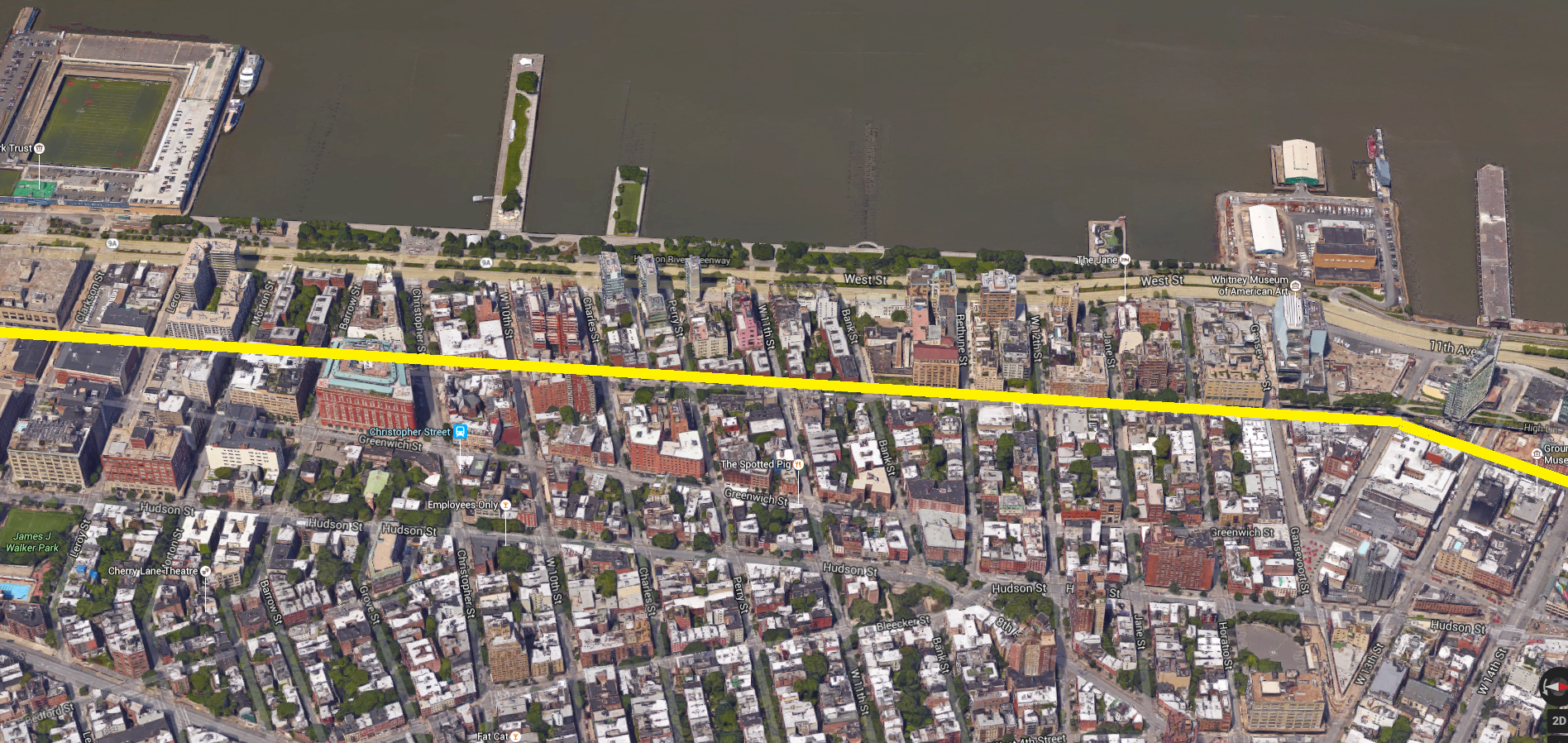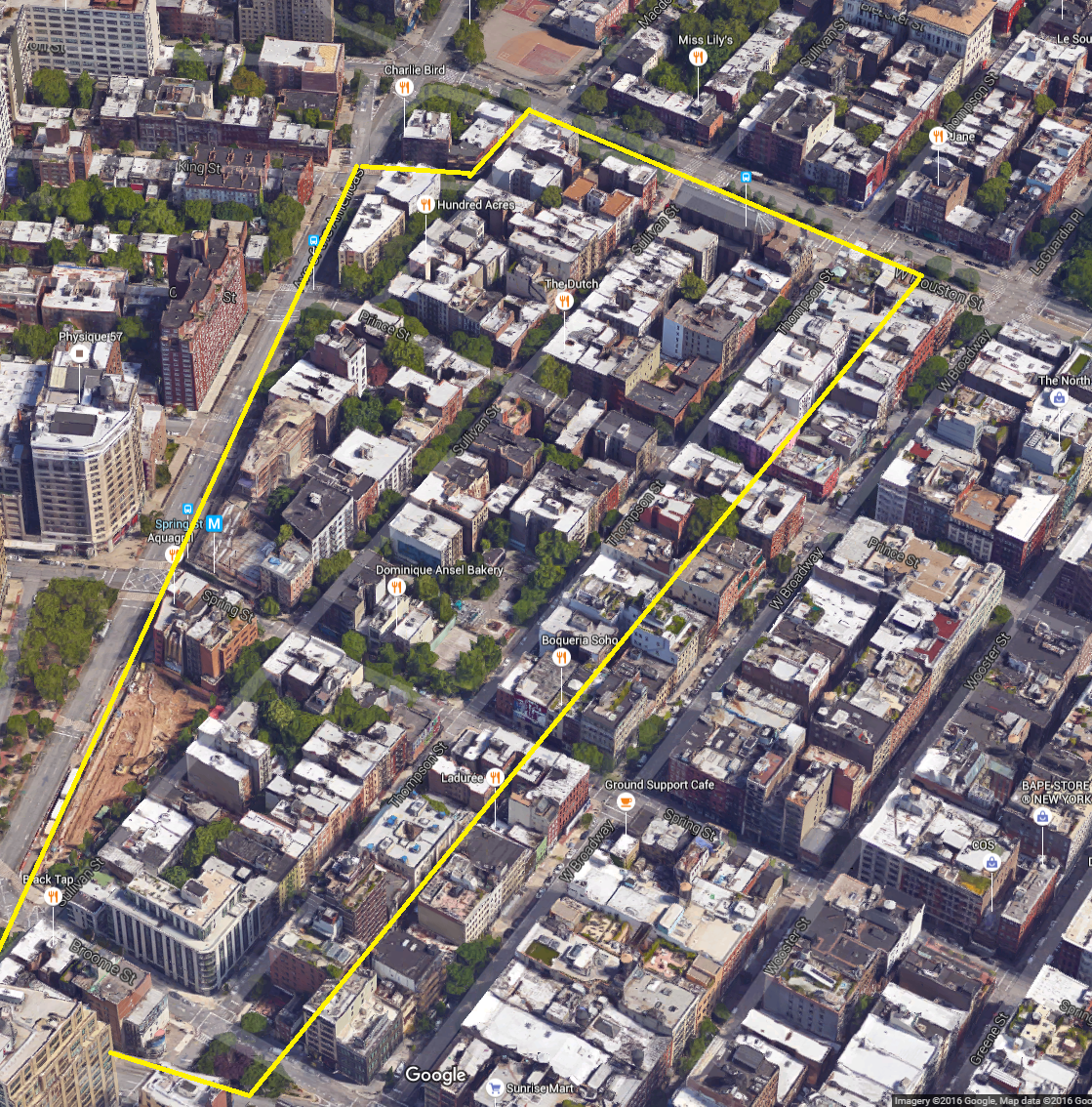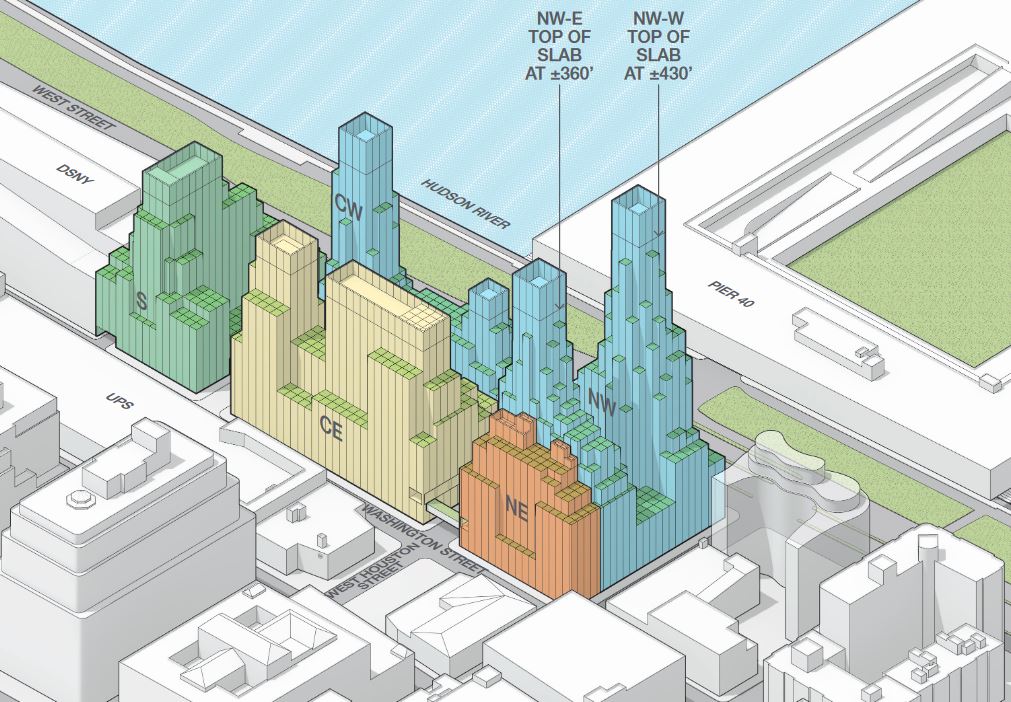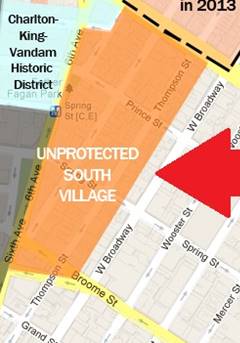
|
Thanks to the NYS Legislature, currently at least 1.5 million additional square feet of “air rights,” or development, could be added to the waterfront blocks in Greenwich Village. |
The Mayor, the Hudson River Park Trust, and a developer have come up with a plan to rezone the three-block St. John’s Terminal site straddling Houston Street between Washington and West Streets. The Mayor and the Trust have also come up with a plan to allow the transfer of “air rights” from the Hudson River Park to sites one block inland from the water, including the St. John’s site, which would increase the size of allowable development there in exchange for funds for the park. Details on the proposal and requested approvals are here.
These plans would have a huge impact upon the entire Hudson River waterfront – the park and adjacent neighborhoods – as well as nearby residential neighborhoods like the South and West Village. And they would set a framework for many, many more potential developments along the waterfront in this area. All this must be approved, modified, or rejected by City Council, as a modified version has been approved by the City Planning Commission.
Few proposals have had as far-reaching and profound a potential impact as this – not only for what it would allow on this one, very large, three-block site, but for the potential impact it could have up and down the waterfront, and upon inland communities.
That’s why GVSHP is demanding that the proposal be radically changed to do the following:
 |
This section of the low-rise, historic, residential South Village, near the proposed St. John’s development, still lacks landmark protections. |
-
Give landmark protections to nearby historic residential neighborhoods like the South Village that currently lack landmark protections, so increased development pressure will not lead their destruction, and their historic character, charm, and scale will be preserved. (As a result of our demands and the support of City Councilmember Corey Johnson, the City has begun the process of considering this, but we need to ensure that it is APPROVED, not just ‘considered,’ before the City Council votes.)
-
Prohibit any further “air rights” transfers from the park that would increase the allowable size of development between 14th Street and Canal Street
-
Remove from any development on the St. John’s site large “destination retail” stores that would generate huge amounts of traffic (as a result of our demands, the City has already removed the "Big Box stores" from the plan) and instead only allow supermarkets and local retail of a reasonable size
There will be one public hearing at the City Council on Tuesday, November 1 at 9:30 a.m at City Hall before the Council votes in December. We need to turn out in large numbers to these hearings and write to city officials to demand these changes.
Here’s What You Can Do:
For more helpful links and documents, click here.

FAQ:
The Pier 40/St. John’s Terminal/Hudson River Park
Special District Plan
What do the City and developers want to build on the St. John’s Terminal Site? They propose a five-building complex including residences, hotels, event space, and 200-300,000 sq ft of retail space, mostly “big box” or “destination” retail – large stores meant to attract people from all over the city and region. It would total just under 2 million square feet of space, with the tallest building reaching well over 450 feet tall. There would be 476 units of affordable housing, much of it for senior citizens, which accounts for 25% of the residential space and 19% of the overall space in the complex. In exchange for being allowed to build an extra 200,000 square feet of space (increasing the development’s size by about 13%), the developer would pay $100 million to the Hudson River Park Trust, which would go towards repairs of the adjacent Pier 40 and its parking and public playing fields.
 |
This rendering shows the proposed mixed-use development at 550 Washington Street. |
What could be built on the site if these approvals are not given? Without granting any approvals, a huge development could be built here anyway. It could be even taller than the current proposal, but significantly less large. It also could not include residences of any sort, and would have no affordable housing. It could be partly hotel and partly offices, with event and some types of other retail or commercial spaces. It would be much, much less profitable to the developer, because residences (which the current zoning does not allow) are the most profitable potential use for the site. But an all office and hotel development might have a bigger impact on the surrounding area than one which is predominantly residential, as proposed. It would also not generate any money for the park or repair of Pier 40.
Why are “air rights transfers” from the Hudson River Park part of the deal? In 2013 the State Legislature approved legislation allowing unused development rights or “air rights” from the Hudson River Park to be transferred one block inland from the park, anywhere from 59th Street to Chambers Street. Commercial piers in the park like Pier 40 have development rights, i.e. things can be built on those piers, and in fact, those piers and whatever structures are on them by law are supposed to generate the revenue for building and maintaining the entire park. However, because there are stricter rules within the park governing what can be built on piers, and because many people want as little built on those piers as possible, the Hudson River Park Trust sought, and got, the State Legislature to allow them to take “development rights” they have from those piers and allow them to sell those rights (air rights) for use on any of the blocks that border the park. The park has an estimated total of 1.5 million square feet of “air rights” it could transfer into the Village or any waterfront block between 59th Street and Canal Street, of which 200,000 sq ft would go towards the St. John’s development, increasing its size by 13%.
GVSHP was totally opposed to the State legislation for a variety of reasons, including that we believe there are better ways to fund repairs for and development of the park, such as placing a dedicated tax on new development next to the park that would go directly to the park, as has been done in Battery Park City and Hudson Yards. We also oppose it because it would greatly increase overdevelopment in our neighborhoods. But the State Legislature passed it, with all our local state legislators supporting it, and the Governor signed it, and they, along with City officials, have refused to consider other funding mechanisms for the park. The State law does require the City to also approve where the air rights can go, which is why it is part of this approval process.
Will this allow more “air rights” from the park the be transferred into our neighborhood, and further increase development on our waterfront blocks? If passed as is, this would in fact be a first step towards allowing another 1.3 million square feet of development rights from the park to be moved into our and other neighborhoods adjacent to the Hudson River Park between 59th and Chambers Streets, though they would require future approvals as well.
What difference would the changes GVSHP is demanding make? The changes we are demanding would make a huge difference. First of all, they would prevent 1.3 million square feet of air rights from potentially being transferred into our neighborhood – that’s the equivalent of about three Trump SoHo’s, and six and a half times the size of the amount of air rights they would transfer as part of this  development. Second, it would put in place landmark protections – the strictest kind of protections available to preserve existing buildings and prevent out-of-scale new development – to eleven low-rise, residential, historic blocks containing over 175 buildings which we have been fighting for ten years to get landmarked. This final phase of our proposed South Village Historic District is gravely endangered, with historic buildings being lost and new out-of-scale development going up every day, and approval of this development would only accelerate that process. Finally, eliminating the “big box” stores and “destination retail” from the plan would get rid of the one of the biggest ways that this development would impact the surrounding neighborhood. While you may see this huge development when nearby, the traffic the enormous “big box” stores and “destination retail” would generate would be felt for blocks and blocks around.
development. Second, it would put in place landmark protections – the strictest kind of protections available to preserve existing buildings and prevent out-of-scale new development – to eleven low-rise, residential, historic blocks containing over 175 buildings which we have been fighting for ten years to get landmarked. This final phase of our proposed South Village Historic District is gravely endangered, with historic buildings being lost and new out-of-scale development going up every day, and approval of this development would only accelerate that process. Finally, eliminating the “big box” stores and “destination retail” from the plan would get rid of the one of the biggest ways that this development would impact the surrounding neighborhood. While you may see this huge development when nearby, the traffic the enormous “big box” stores and “destination retail” would generate would be felt for blocks and blocks around.
This development, and this process, sounds terrible. Why not just oppose the approvals altogether? The development and the process are awful, and if these very significant changes we are asking for are not made, we are absolutely opposed to the approvals and the development. But there are a few reasons why we are not simply unconditionally calling for the approvals to be voted down:
1. Whether we like it or not, the approvals are not going to be voted down in this case. The Mayor is clearly committed to them, as is the City Planning Commission. The Borough President and the City Councilmember for the area have already indicated that they support some package of changes and approvals here, in order to generate revenue for the park and affordable housing, but they are willing to demand changes and additions.
2. There is actually a very large constituency of neighborhood residents who are in favor of these approvals. Thousands of local residents who use the public playing fields on Pier 40 have come out in support of this plan, because they think it is the only way ensure that the rapidly deteriorating Pier 40, which was damaged by Superstorm Sandy, can be repaired in time to prevent loss of the playing fields, upon which thousands of children and adults depend. We strongly believe that there are funding alternatives if the political will were there from city and state officials. But that will does not appear to be there.
3. If these approvals were denied, that would not be a great outcome either. Under existing zoning and without any approvals, a huge development could be built on this site, which could be just as impactful or arguably even more impactful than what is proposed. And it would have none of the upsides of what we are fighting for or what has been proposed – no landmark protections for neighboring areas, lots of intensively traffic generating uses, no money to repair Pier 40, and no affordable housing. AND it would mean that the full 1.5 million square feet of development rights from the park which the State Legislature has allowed to be transferred inland to our neighborhood would still be floating out there, just waiting for an opportunity to be placed in our neighborhood and abetting enormous overdevelopment. This way, just 13% of those air rights are used in this one location, and no other air rights from the park are ever allowed to be used in our neighborhood again.
So even if it were possible, getting all the approvals voted down is not a great option either. Are there downsides to even the modified approvals that we are asking for being given? Yes. But there are some very, very significant upsides as well. Is this process severely lacking and reflective of some serious deficiencies on the part of city and state officials who are unwilling to consider better, fairer options? Absolutely. But this appears to be the best outcome possible in the circumstances we face, which will make some very significant progress on several very important preservation fronts.